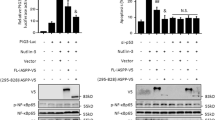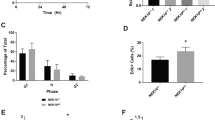Abstract
AKT activation enhances resistance to apoptosis and induces cell survival signaling through multiple downstream pathways. We now present evidence that AKT is activated in HTLV-1-transformed cells and that Tax activation of AKT is linked to NF-κB activation, p53 inhibition and cell survival. Overexpression of AKT wild type (WT), but not a kinase dead (KD) mutant, resulted in increased Tax-mediated NF-κB activation. Blocking AKT with the PI3K/AKT inhibitor LY294002 or AKT SiRNA prevented NF-κB activation and inhibition of p53. Treatment of C81 cells with LY294002 resulted in an increase in the p53-responsive gene MDM2, suggesting a role for AKT in the Tax-mediated regulation of p53 transcriptional activity. Further, we show that LY294002 treatment of C81 cells abrogates in vitro IKKβ phosphorylation of p65 and causes a reduction of p65 Ser-536 phosphorylation in vivo, steps critical to p53 inhibition. Interestingly, blockage of AKT function did not affect IKKβ phosphorylation of IκBα in vitro suggesting selective activity of AKT on the IKKβ complex. Finally, AKT prosurvival function in HTLV-1-transformed cells is linked to expression of Bcl-xL. We suggest that AKT plays a role in the activation of prosurvival pathways in HTLV-1-transformed cells, possibly through NF-κB activation and inhibition of p53 transcription activity.
This is a preview of subscription content, access via your institution
Access options
Subscribe to this journal
Receive 50 print issues and online access
$259.00 per year
only $5.18 per issue
Buy this article
- Purchase on Springer Link
- Instant access to full article PDF
Prices may be subject to local taxes which are calculated during checkout







Similar content being viewed by others
References
Akagi T, Ono H and Shimotohno K . (1995). Blood, 86, 4243–4249.
Bellacosa A, Testa JR, Staal SP and Tsichlis PN . (1991). Science, 254, 274–277.
Cantley LC and Neel BG . (1999). Proc. Natl. Acad. Sci. USA, 96, 4240–4245.
Downward J . (2004). Semin. Cell Dev. Biol., 15, 177–182.
Dudek H, Datta SR, Franke TF, Birnbaum MJ, Yao R, Cooper GM, Segal RA, Kaplan DR and Greenberg ME . (1997). Science, 275, 661–665.
Fresno Vara JA, Casado E, de Castro J, Cejas P, Belda-Iniesta C and Gonzalez-Baron M . (2004). Cancer Treat. Rev., 30, 193–204.
Gessain A, Barin F, Vernant JC, Gout O, Maurs L, Calender A and de The G . (1985). Lancet, 2, 407–410.
Gills JJ and Dennis PA . (2004). Expert. Opin. Invest. Drugs, 13, 787–797.
Grassmann R, Dengler C, Muller-Fleckenstein I, Fleckenstein B, McGuire K, Dokhelar MC, Sodroski JG and Haseltine WA . (1989). Proc. Natl. Acad. Sci. USA, 86, 3351–3355.
Hovelmann S, Beckers TL and Schmidt M . (2004). Br. J. Cancer, 90, 2370–2377.
Jeong SJ, Pise-Masison CA, Radonovich MF, Park HU and Brady JN . (2005). J. Biol. Chem., 280, 10326–10332.
Jeong SJ, Radonovich M, Brady JN and Pise-Masison CA . (2004). Blood, 104, 1490–1497.
Kauffmann-Zeh A, Rodriguez-Viciana P, Ulrich E, Gilbert C, Coffer P, Downward J and Evan G . (1997). Nature, 385, 544–548.
Kulik G, Klippel A and Weber MJ . (1997). Mol. Cell Biol., 17, 1595–1606.
Levine AJ . (1997). Cell, 88, 323–331.
Liu Y, Wang Y, Yamakuchi M, Masuda S, Tokioka T, Yamaoka S, Maruyama I and Kitajima I . (2001). Oncogene, 20, 2514–2526.
Luo J, Manning BD and Cantley LC . (2003). Cancer Cell, 4, 257–262.
Madrid LV, Wang CY, Guttridge DC, Schottelius AJ, Baldwin Jr AS and Mayo MW . (2000). Mol. Cell Biol., 20, 1626–1638.
Mayo LD and Donner DB . (2002). Trends Biochem. Sci., 27, 462–467.
Mochizuki M, Watanabe T, Yamaguchi K, Takatsuki K, Yoshimura K, Shirao M, Nakashima S, Mori S, Araki S and Miyata N . (1992). Jpn. J. Cancer Res., 83, 236–239.
Nerenberg M, Hinrichs SH, Reynolds RK, Khoury G and Jay G . (1987). Science, 237, 1324–1329.
Nishioka K, Maruyama I, Sato K, Kitajima I, Nakajima Y and Osame M . (1989). Lancet, 1, 441.
Osame M, Usuku K, Izumo S, Ijichi N, Amitani H, Igata A, Matsumoto M and Tara M . (1986). Lancet, 1, 1031–1032.
Ozes ON, Mayo LD, Gustin JA, Pfeffer SR, Pfeffer LM and Donner DB . (1999). Nature, 401, 82–85.
Parsons R . (2004). Semin. Cell Dev. Biol., 15, 171–176.
Pise-Masison CA, Mahieux R, Jiang H, Ashcroft M, Radonovich M, Duvall J, Guillerm C and Brady JN . (2000). Mol. Cell Biol., 20, 3377–3386.
Poiesz BJ, Ruscetti FW, Gazdar AF, Bunn PA, Minna JD and Gallo RC . (1980). Proc. Natl. Acad. Sci. USA, 77, 7415–7419.
Raina D, Kharbanda S and Kufe D . (2004). J. Biol. Chem., 279, 20607–20612.
Ren S, Gao C, Zhang L, Koike K and Tsuchida N . (2003). Biochem. Biophys. Res. Commun., 308, 120–125.
Scheid MP and Woodgett JR . (2003). FEBS Lett., 546, 108–112.
Shan X, Czar MJ, Bunnell SC, Liu P, Liu Y, Schwartzberg PL and Wange RL . (2000). Mol. Cell Biol., 20, 6945–6957.
Sherr CJ . (1998). Genes Dev., 12, 2984–2991.
Sizemore N, Lerner N, Dombrowski N, Sakurai H and Stark GR . (2002). J. Biol. Chem., 277, 3863–3869.
Sizemore N, Leung S and Stark GR . (1999). Mol. Cell Biol., 19, 4798–4805.
Slee EA, O’Connor DJ and Lu X . (2004). Oncogene, 23, 2809–2818.
Songyang Z, Baltimore D, Cantley LC, Kaplan DR and Franke TF . (1997). Proc. Natl. Acad. Sci. USA, 94, 11345–11350.
Staal SP, Hartley JW and Rowe WP . (1977). Proc. Natl. Acad. Sci. USA, 74, 3065–3067.
Tanaka A, Takahashi C, Yamaoka S, Nosaka T, Maki M and Hatanaka M . (1990). Proc. Natl. Acad. Sci. USA, 87, 1071–1075.
Thompson JE and Thompson CB . (2004). J. Clin. Oncol., 22, 4217–4226.
Vernant JC, Buisson G, Magdeleine J, De Thore J, Jouannelle A, Neisson-Vernant C and Monplaisir N . (1988). Lancet, 1, 177.
Vousden KH and Lu X . (2002). Nat. Rev. Cancer, 2, 594–604.
Vousden KH . (2000). Cell, 103, 691–694.
Yang F, Tang E, Guan K and Wang CY . (2003). J. Immunol., 170, 5630–5635.
Yoshida M, Miyoshi I and Hinuma Y . (1982). Proc. Natl. Acad. Sci. USA, 79, 2031–2035.
Acknowledgements
We thank members of Dr Brady's laboratory for helpful discussion and the FACS core facility of CCR, NCI and NIH for flow cytometry analysis.
Author information
Authors and Affiliations
Corresponding author
Rights and permissions
About this article
Cite this article
Jeong, SJ., Pise-Masison, C., Radonovich, M. et al. Activated AKT regulates NF-κB activation, p53 inhibition and cell survival in HTLV-1-transformed cells. Oncogene 24, 6719–6728 (2005). https://doi.org/10.1038/sj.onc.1208825
Received:
Revised:
Accepted:
Published:
Issue Date:
DOI: https://doi.org/10.1038/sj.onc.1208825
Keywords
This article is cited by
-
FAM83B promotes the invasion of primary lung adenocarcinoma via PI3K/AKT/NF-κB pathway
BMC Pulmonary Medicine (2023)
-
Activation of MG53 Enhances Cell Survival and Engraftment of Human Induced Pluripotent Stem Cell-Derived Cardiomyocytes in Injured Hearts
Stem Cell Reviews and Reports (2023)
-
An acquired phosphatidylinositol 4-phosphate transport initiates T-cell deterioration and leukemogenesis
Nature Communications (2022)
-
The antipsychotic agent trifluoperazine hydrochloride suppresses triple-negative breast cancer tumor growth and brain metastasis by inducing G0/G1 arrest and apoptosis
Cell Death & Disease (2018)
-
Cinchonine induces apoptosis of HeLa and A549 cells through targeting TRAF6
Journal of Experimental & Clinical Cancer Research (2017)



